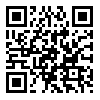Volume 6, Issue 2 (Summer 2019)
jhbmi 2019, 6(2): 90-100 |
Back to browse issues page
Download citation:
BibTeX | RIS | EndNote | Medlars | ProCite | Reference Manager | RefWorks
Send citation to:



BibTeX | RIS | EndNote | Medlars | ProCite | Reference Manager | RefWorks
Send citation to:
Rezayi S, Safaei A A, Mohammadzadeh N. Requirements for Designing a Wearable Smart Blanket System for Monitoring Patients in Ambulance. jhbmi 2019; 6 (2) :90-100
URL: http://jhbmi.ir/article-1-332-en.html
URL: http://jhbmi.ir/article-1-332-en.html
Assistant Professor, Software Engineering, Medical Informatics Dept., Faculty of Medical Sciences, Tarbiat Modares University, Tehran, Iran
Abstract: (6965 Views)
Introduction: Nowadays, smart systems and advanced tools such as wearable systems have grown significantly in order to monitor patients and keep their condition under control. The aim of this study was to determine the requirements for designing a wearable smart blanket system (WSBS) to monitor patients in ambulance instantaneously.
Method: After reviewing the characteristics of wearable systems by conducting a comparative study, the requirements for designing the proposed system were determined using appropriate data collection methods. In the first step, studies were conducted to identify the requirements for the development of wearable systems, and in the second step, a questionnaire obtained from the studies was distributed among specialists, and based on the results obtained from the questionnaire, the requirements for designing the system were determined.
Results: Wearable Smart Blanket System (WSBS) has special functional features such as monitoring of vital signs, ability to communicate with the environment, instantaneous processing of vital signs, the ability to alert when vital signs exceed the threshold, and the ability to record all the patients' vital signs. The main non-functional features of WSBS include easy installation and operation, interoperability, error tolerance, low power consumption, accuracy of signs recording, data evaluation and analysis.
Conclusion: The WSBS records all the vital signs needed for the control of patients seamlessly and provides interpreted data for the ambulatory treatment team. All patients' medical, diagnostic, and monitored health information are stored in the physician assistants' system, and therefore, allows them to provide early diagnosis.
Method: After reviewing the characteristics of wearable systems by conducting a comparative study, the requirements for designing the proposed system were determined using appropriate data collection methods. In the first step, studies were conducted to identify the requirements for the development of wearable systems, and in the second step, a questionnaire obtained from the studies was distributed among specialists, and based on the results obtained from the questionnaire, the requirements for designing the system were determined.
Results: Wearable Smart Blanket System (WSBS) has special functional features such as monitoring of vital signs, ability to communicate with the environment, instantaneous processing of vital signs, the ability to alert when vital signs exceed the threshold, and the ability to record all the patients' vital signs. The main non-functional features of WSBS include easy installation and operation, interoperability, error tolerance, low power consumption, accuracy of signs recording, data evaluation and analysis.
Conclusion: The WSBS records all the vital signs needed for the control of patients seamlessly and provides interpreted data for the ambulatory treatment team. All patients' medical, diagnostic, and monitored health information are stored in the physician assistants' system, and therefore, allows them to provide early diagnosis.
Keywords: Monitoring vital signs, Wearable systems, Wearable smart blanket requirements, Smart sensors and fibers
eprint link: http://eprints.kmu.ac.ir/id/eprint/31509
eprint link: http://eprints.kmu.ac.ir/id/eprint/31509
Audio file [MP3 1072 KB] (188 Download)
Send email to the article author
| Rights and permissions | |
 |
This work is licensed under a Creative Commons Attribution-NonCommercial 4.0 International License. |




